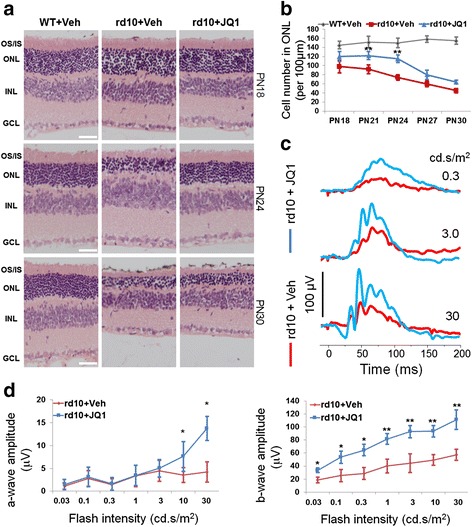Fig. 1.

JQ1 treatment preserves photoreceptor number and function in rd10 mice. Vehicle (DMSO) and JQ1 (0.1 mM) were intravitreally injected, respectively, into one eye and the contralateral eye of rd10 mice at PN14. WT (B6) mice were injected only with vehicle. At PN18, PN21, PN24, PN27, and PN30, mice were either subjected to ERG measurements, or sacrificed for preparation of retinal sections. a Representative H&E-stained retinal paraffin sections showing a protective effect of JQ1 on ONL thickness in rd10 mice. OS/IS outer/inner segment, ONL outer nuclear layer, INL inner nuclear layer, GCL ganglion cell layer. Scale bar 50 μm. For images of PN21 and PN27, see Additional file 1: Figure S1. b Quantification for a: photoreceptor cell number per 100 μm ONL length; mean ± SEM, n = 6 mice; **P < 0.01 compared to rd10 vehicle control. c Representative ERG traces (measured at PN24, in response to 0.3, 3, or 30 cd s/m2 light intensity of flashes) showing rescue of rd10 mouse retinal function by JQ1 treatment. d Quantification of a-wave and b-wave amplitudes. ERG a-wave is the downward deflected negative response; b-wave is from the a-wave peak to positive response peak. Oscillatory potential is visible superimposed on b-wave. Data are presented as mean ± SEM, n = 10 mice, *P < 0.05, **P < 0.01 compared to rd10 vehicle control
